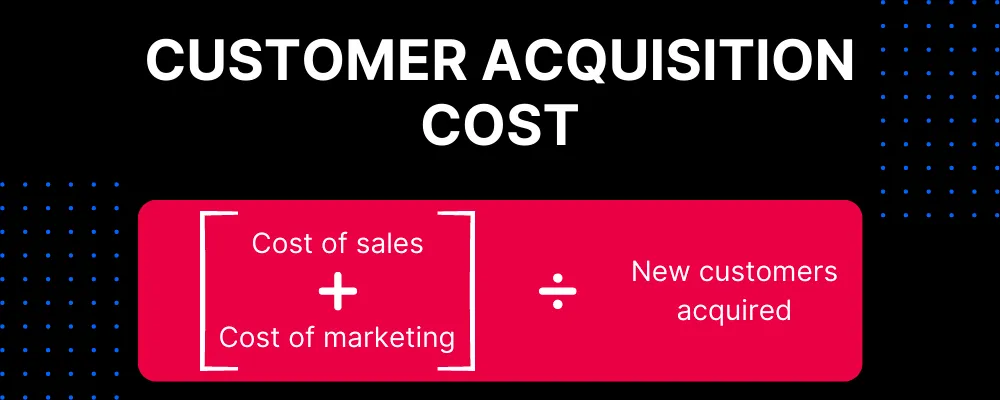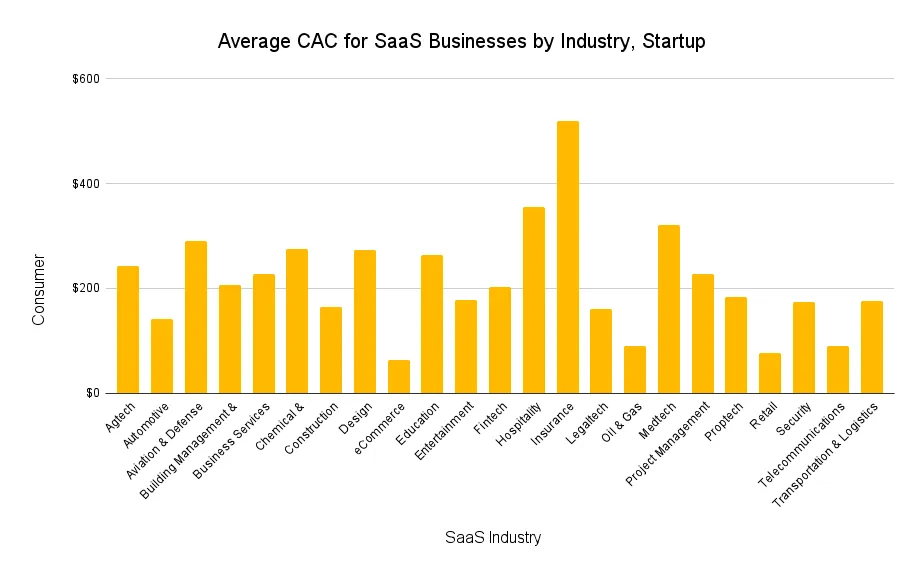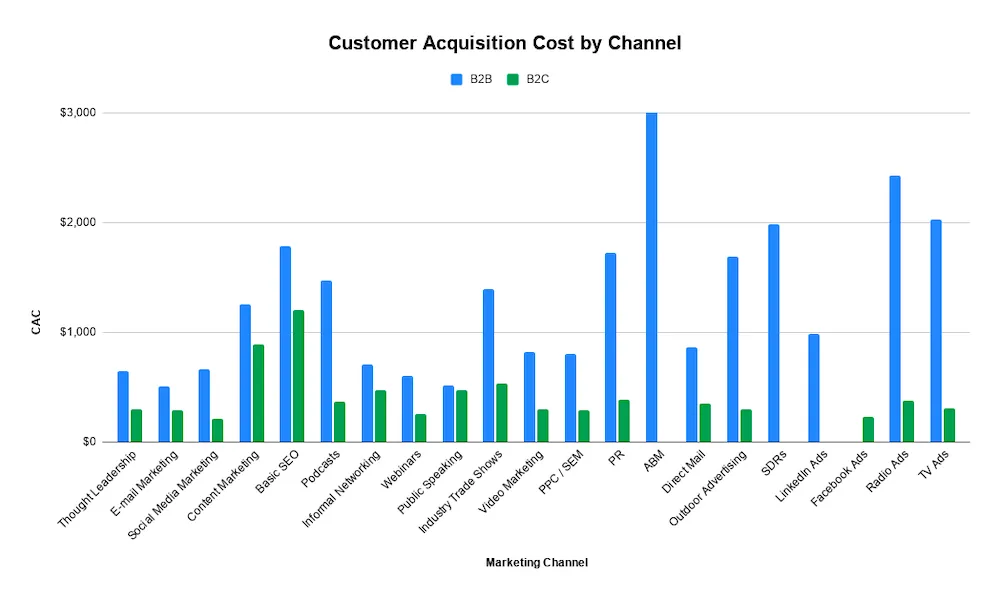
Venture-backed startups used to try and grow at all costs. Software companies have been especially hot, with venture capital rolling in right and left. So, a high cost of customer acquisition wasn’t much of a problem. Until 2021.
Fast forward to now. With many economists predicting some kind of recession, IT spending has slowed. Founders now want (or feel compelled) to pursue efficient growth. They’re aiming to minimize sales and marketing expenses, trying to get fit so they can make it through the storm. And now, customer acquisition cost has become one of the most important KPIs (and point of contention).poignantly relevant.
Today, I’ll walk you through its basics—how to use this key metric to improve your business and sales strategies, along with tactics to reduce your sales and marketing costs. Let’s go.
What Is Customer Acquisition Cost?
Customer acquisition cost (CAC) is the average expenditure your company makes to win a new customer for your product or service. It includes advertising costs, sales and marketing spend, the salaries and commissions for your teams, and so on.
This metric helps you get context on the amount of money, time, and effort required to achieve profitable growth. If your CAC is greater than the revenue your company generates for long enough, it indicates that your business model is unviable and unsustainable.
As a sales professional, you can use CAC to guide the investments you make in acquisition. If certain channels carry a lower CAC to generate new leads, you might consider doubling down.
How to Calculate CAC
To calculate CAC for your business, follow this simple, step-by-step method:
Step 1: Choose the Period to Calculate It Over
Maybe it's a month, quarter, or year. You first need to settle upon the specific time period for which you want to calculate CAC.
Step 2: Calculate Your Total Expenses to Acquire Customers
Now, collect all of the relevant costs for acquiring an average customer in your selected time period. Include the salaries of your sales and marketing teams, software expenses, advertising costs, and any other related expenses.
Step 3: Find the Total Number of New Customers
For your selected period, pull up your customer relationship management (CRM) software and find the total number of customers that made their first purchase.
Step 4: Calculate CAC
Once you have the relevant info from the previous steps, use this CAC calculation formula:
(Cost of Sales + Marketing) / Number of New Customers Acquired = CAC
 |
Key Components of CAC
The CAC typically consists of two types of costs: fixed and variable.
- Fixed costs: These expenditures remain relatively constant, irrespective of the number of customers you acquire. It can include costs for content creation, website maintenance, employee salaries, agency fees, software subscriptions, and more.
- Variable costs: These costs rise or fall in proportion to your customer acquisition activities. They include sales commissions, costs incurred while attending events and conferences (for booths, travel, etc.), advertising and lead generation costs, expenses for running promotional offers, and more.
Carefully monitor both fixed and variable costs to identify the areas where you can reduce expenses and keep customer acquisition cost-efficient.
CAC Calculation Examples
Let’s look at a couple of examples to illustrate how to calculate the acquisition cost of a customer.
Example 1: Let’s say a self-serve SaaS startup spends $75,000 a year on its SEO and content marketing efforts. They only have one sales professional, which is an expense of $50,000 a year. The technical upkeep of the software and customer support requires an additional $100,000.
The company found that the total number of new paying customers acquired in the last year was 2,500, as a result of these efforts.
Using our formula:
CAC = ($75k + $50k + 100k)/2500 = $90
Example 2: Now imagine a DTC eCommerce company that sells organic skincare products. In the last quarter, their marketing strategies consisted of paying influencers to promote their new product launches ($50,000), and an additional social media ad spend of $45,000.
For this total cost of $95,000, they ended up with 10,000 new customers. The CAC, in this case, comes out to:
($50,000 + $45,000)/10,000 = $9.50
This number may seem low, but you need to monitor other business metrics to put things in perspective.
What is the average value of the first order an average customer places? Are they buying from the brand recurrently, for a period of time? Or churning after one purchase? We’ll discuss metrics like customer lifetime value (CLV) and CAC ratio below.
Customer Acquisition Cost Benchmarks
Is your customer acquisition spending reasonable? You need the context of other metrics to answer that question satisfactorily, but industry benchmarks provide a good starting point.
Here’s a data set by FirstPageSage, based on their experience of running organic and paid marketing for SaaS companies over twelve years. They have classified CAC by industry and customer type. Here’s the data plotted for startups:
 |
For instance, the average CAC for an SMB in the ad tech industry comes out to $560.
FirstPageSage has also put together benchmarks for CAC by channel. And the average B2B SaaS CAC for all organic channels is $942. That number is $1907 for inorganic channels. Check this out:
 |
How do you compare? Regardless, don’t despair. Now that we have established some benchmarks, how can CAC enhance your strategy?
3 Ways to Use CAC to Amplify Your Business Strategy
CAC is a vital metric. But it’s best used in conjunction with other business metrics for informing your sales and marketing decisions.
Here are a few ways you can leverage it to strengthen your business strategy.
1. Use Customer Acquisition Cost to Optimize Profitability
Most SaaS businesses spend a decent amount of money and time before seeing a return on investment (ROI). If you want your business to grow sustainably, you have to recoup your investment ASAP.
You have to optimize and reduce the time it takes to break even—referred to as the CAC payback period.
 |
You also need to maximize the revenue generated from customers (customer lifetime value, or CLV).
 |
Most SaaS companies consider the CLV/CAC ratio to be one of the most important metrics to determine efficient growth. As a general rule, you want to track the ratio every quarter—and you want the ratio to be over three. This means that for every dollar spent on customer acquisition, your business earns $3 (in the long run).
If the ratio is too low, it’s a sign to reduce your marketing expenses—or speed up your sales process. Because ultimately, you want to maximize profitability. (And here’s a spreadsheet template by startup advisor Jessica Z to calculate your ELTV to ECAC ratio.)
On the other hand, David Spitz helps SaaS CEOs and CFOs optimize performance with benchmarking—and he considers most of the above numbers to be “compound metrics” where you can’t see what’s really going on.
He prefers to start with a more fundamental metric: sales efficiency. And he uses the following question to compute it: “How much does it cost to sell $1 of new Annual Recurring Revenue (the ‘CAC Ratio’)?”
For private companies, he says, the calculation is simple. “Determine what your team sold and what you paid (or will pay) them for those sales. Then do the division. And forget deferred commissions and revenue recognition (learn why here).”
Regardless of your approach, your ultimate goal with this is to turn net profitable ASAP.
2. Lean on the CAC Ratio to Calculate Your Sales Team’s Efficiency
If you want to improve the performance of your sales team, Ray Rike, CEO of Benchmarkit, recommends using the sales development CAC Ratio. He considers it to be one of the top metrics to track “departmental revenue efficiency.” And it’s “seldom used” by B2B SaaS companies.
Here’s his suggested formula for the sales development CAC ratio:
Sales Development CAC Ratio: Pipeline
(Fully-loaded Sales Development expenses / Qualified Pipeline ($) from outbound SDR- generated leads)
This formula does not include pipeline or new CARR generated from inbound leads.
Sales Development CAC Ratio: Contracted Annual Recurring Revenue (CARR)
(Fully-loaded Sales Development expenses / New CARR($) from outbound SDR-generated leads).
Why bother? Because an expense-efficient team leads to a profitable company.
3. Let CAC Inform Your Business Decisions
If you know your customer acquisition cost and the number of customers gained every quarter, you can make accurate sales forecasts. Suppose you want to raise capital for your startup. You can prove to investors that you have a viable business model by positioning your acquisition costs beside the payback period and LTV.
You can also dive deeper into analyzing the acquisition costs for specific products, marketing channels, customer segments, re-attracting churned customers, and more.
As your business grows, you’ll invest in a diverse sales and marketing mix, relying on different channels. Based on your CAC, you can allocate budget and resources to the most profitable channels.
Suppose your cost of acquiring customers from Google Ads is much higher than SEO, and you want free cash flow in the next quarter. You can reallocate your budget and resources to SEO to acquire customers more cheaply.
And if you want to improve profit margins (and CAC is too high), consider changing your pricing strategy. Or, bundle different products together to boost the average transaction value.
8 Strategies to Optimize Your CAC and Improve Your ROI
“When you really boil it down, customer acquisition cost comes down to just two factors: volume and efficiency. Volume is the number of potential buyers you can get at the top of your funnel. Efficiency is how well you can turn them into customers,” says Aaron Tian, a senior growth marketer at Close.
Here are eight strategies to improve your marketing and sales efforts, in order to optimize volume and efficiency. Let’s start with marketing first.
Improving Marketing Efficiency
Ready to improve your marketing efficiency and optimize your CAC?
1. Gain a Deeper Understanding of Your Ideal Customer Demographics
Do you know what your ideal customers look like?
If not, you should create an ideal customer profile (ICP). The ICP will enable you to create targeted campaigns, tailor your messaging to their unique needs, focus on the right marketing channels (where they hang out), optimize your advertising spend, and more. Below is a glimpse into the data points an ideal customer profile might include.
 |
Your sales team can also use the ICP—prioritizing selling to the most viable potential customers.
2. Target Your Marketing and Advertising
Once you know your ICP, you can laser-focus your content marketing, advertising, and other campaigns. Personalize the experience for your ICP, and don’t worry about churn from other prospects.
You can also retarget your website visitors via PPC ads. These prospects are already aware of your brand, so advertising costs tend to be lower.
3. Leverage Data Analytics to Optimize Marketing Campaigns
Whether using SEO, PPC, email, or another marketing channel, you need to have accurate tracking info from each channel in order to get benchmarks on their conversion rates and CAC. From there, perform A/B testing to optimize copy, elevate the user experience, and so on.
Analytics can also reveal the top keywords, topics, and gaps in your content strategy.
A robust CRM (like Close) can integrate with Google Analytics (and a bunch of other tools) to provide deeper insights into the most successful revenue-driving campaigns.
4. Experiment with Affiliate Marketing
Brandon Fishman, CEO at VitaCup, recommends using affiliate marketing as a channel because it “has fixed costs or a fixed CAC” to it.
Here are the two types of affiliate marketing he suggests: “You can use a network like Commission Junction or Impact Radius to access sites like Ebates. Most coupon-based sites will market your product for a small percentage of the sale.
“Or, you can work directly with top affiliate marketers on a cost-per-sale basis. These affiliates will run their own media on Meta, display, email, and other channels, and charge you a fixed cost per sale.
“Make sure you only pay them out on new customers and not repeat customers”, he concludes.
The above are relevant strategies to reduce total marketing expenses. But Aaron (at Close) reminds marketers to not lose the forest for the trees when discussing cost optimization.
“Yes, there’s a science to this process. And yes, A/B testing and analysis can help you solve challenging problems. But I think marketers can get compartmentalized when they think too hard about how to make every step of their funnel picture perfect. It’s easy (and tempting) to overanalyze every friction point, landing page, CTA button, price point, and so on.”
Aaron recommends using these questions to gut-check your marketing:
- Does the whole customer journey make sense?
- Does it feel natural, easy, and enjoyable?
- Is it something you would recommend to your friends?
“If you’re doing it right, the customer acquisition costs and other KPIs will follow”, he says.
Improving Sales Efficiency
Now let’s look at a few strategies to optimize your sales expenses and productivity, thereby improving your CAC.
5. Streamline Your Sales Process
Do you have a documented process that your sales reps follow to take a lead from qualification to discovery—all the way to closing the deal? If not, start by creating a sales process, following the steps below.
 |
Avi Mesh, Enterprise AE at Orum, reminds us that the goal of your sales process is to “make it as easy as possible for buyers to buy.”
Do this by helping them:
- Craft airtight ROI estimations
- Navigate their own internal process
- Tie your product back to executive priorities
- Present business cases to other stakeholders
6. Shorten Your Sales Cycle
Sales cycles in B2B SaaS can get really, really long—involving multiple decision-makers. By shortening them, you can reduce fixed costs and acquire more customers at the same time—thereby reducing CAC.
There are various ways to shorten your sales cycle, such as investing in AI-enabled buyer journeys, ensuring you’re speaking with the right decision-makers, being upfront with your pricing, and so on. Also, consider your prospect’s buying process—and attack it on multiple fronts, at the same time.
7. Focus on Customer Retention to Control Acquisition Costs
It’s established business wisdom: Retaining customers is cheaper than acquiring new ones. But given current economic conditions, retention has become even more important. The 2023 SaaS Capital retention benchmarks found that the median net revenue retention (NRR) is 102 percent. Also, the growth rate was positively and exponentially correlated with net revenue retention.
 |
As a sales professional, you build rapport with prospects before closing a deal—and that should continue beyond. Regularly check in with customers to address any issues they encounter, and ensure they get maximum value out of your product or service.
You can even deepen a customer relationship by cross-selling and upselling relevant offerings (when applicable), which further boosts CLV.
8. Cut Unused SaaS Subscriptions
Software subscriptions can help with automation and other tasks. But many of them go unused, increasing your fixed monthly costs. And in a recent survey, organizations worldwide claimed to have an average of 130 SaaS applications. Yikes!
Ash Didwania helps B2B SaaS Companies get from $0 to $100M ARR. He describes these costs as “tiny droplets that make up the ocean.” Reducing subscriptions was one of the steps that helped cut the CAC for a B2B SaaS, early 6-figure ACV—by 40 percent over six months.
 |
Tracking Customer Acquisition Cost for Profitable Growth
CAC is one metric that demonstrates the effectiveness of your sales and marketing strategies. But you must track it alongside CLV, CAC ratio, payback period, and free cash flow to gain a deeper understanding about the health of your business.
Ready to improve your profit margin and build the foundation for sustainable growth? Then commit to maintaining a low customer acquisition cost. (The above strategies will help you do that.)
Another way to lower CAC is by implementing the right CRM. Close is built for speed and productivity—and supports efficient outreach and customer engagement. Start a 14-day free trial to kick off your cost-optimization journey.










